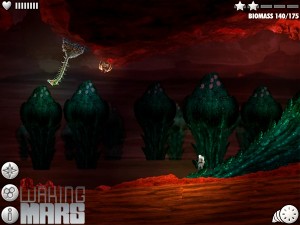You describe Tiger Style as a “distributed collective.” Does that mean all team members are spread far and wide, or is there also a central nucleus with a few members living in the same area? Has the team added members or restructured in any way since the release of Spider: The Secret of Bryce Manor?
David Kalina: We don’t have a shared office space, so we are still technically distributed, but less so these days than during Spider. When we were making Spider, I lived in Austin, Texas, while Randy lived up in Burlington, Vermont, and we communicated over video chat daily. Randy has since moved back to Austin, which means we mostly meet at coffee shops in our neighborhood and work out of our homes. We also did weekly playtests out of my place over much of the last six months of the project, and our local team members would come by and observe people playing the game in progress.
We also have a stronger presence locally than we used to – excellent environment artist Amanda Williams and musician Ethan Frederick Greene are Austin-based, and we recently added sound designer Bobby Arlauskas and audio programmer Damien Di Fede as new team members – but we still have people all over. Scott Barber (musician) and Jen Cha (animator) are in Los Angeles. Randy O’Connor (artist/designer) is in Berkeley. Rick Tossavainen (programmer) is in Washington, D.C. Jef Drawbaugh, another musician, is in Portland, Oregon. We enjoy collaborating with excellent creative people, and it sort of doesn’t matter where they live anymore.
 We first learned about your upcoming title under the name Lost Mars. Of course, it was never really set in stone at that point, but what was the final event that caused the switch to Waking Mars? And just how important is it for an indie team to have a legal expert handy these days?
We first learned about your upcoming title under the name Lost Mars. Of course, it was never really set in stone at that point, but what was the final event that caused the switch to Waking Mars? And just how important is it for an indie team to have a legal expert handy these days?
David: We have a lawyer who we try to contact as infrequently as possible (they’re expensive!) and after deciding on Lost Mars, it occurred to me that there is a certain Konami-owned property that has an awfully similar name. I ran it by our lawyer – would it be risky trademark business to go with that name? – and he sufficiently scared us off.
Waking Mars was always my personal #1 and was under heavy consideration for a long time, so it was an easy switch and I’m glad that we made it for creative reasons. It has an active feel; it indirectly describes what you do in the game that is unique to the fiction, and it’s evocative and has a good cadence.
 Tell our readers a little about Liang Qi and the game’s “Action Gardening” premise. Were living beings introduced on Mars by humanity, or did they evolve unseen for millennia before Liang found them underground?
Tell our readers a little about Liang Qi and the game’s “Action Gardening” premise. Were living beings introduced on Mars by humanity, or did they evolve unseen for millennia before Liang found them underground?
Randy Smith: In Waking Mars you play as Liang Qi, the world’s most famous astronaut: the Neil Armstrong of the future, the hero of the Chinese space program, heading up a mission for the Global Space Agency to investigate a cave on Mars in which alien life forms have been discovered. When disaster befalls the mission, he finds himself trapped underground, forced to understand and master the interconnected ecosystem of alien creatures if he hopes to survive. Along the way he stumbles upon secrets that have lain buried under the surface of Mars for billions of years, and he will ultimately make a decision that determines the fate of a lost planet.
We refer to the Waking Mars gameplay as “action ecosystem” gameplay. As you explore the caverns under Mars, you discover and research new life forms, learning the diets, vulnerabilities, and special behaviors of each, including how they relate to each other as a living, breathing ecosystem. The connections grow with each new creature encountered, giving you new ways to interact. You can use the seeds from a Hydron to water a Halid, which will heal you if you get injured. You can chase Phyta into a Prax, which will eat them, then spit out a seed you can grow if you can find the type of terrain it requires. Cycots fly around in search of food, and after one picks some up you can follow it back to its nest. If Larians consume certain creatures they spit out a very valuable object as a byproduct, so try feeding them different things until you figure it out. The seeds from Feran explode, so you can use them to blast through rubble and other obstacles.
 Your goal in most chambers of the cave is to create – not destroy – life. You must raise the biomass to a high level, which means you have to figure out the best type of ecosystem to cultivate. The choice is important, because some ecosystems are more valuable than others, but some are more dangerous than others too, and interesting, clever solutions are possible as well. Our players sometimes get past difficult obstacles by thinking up a smart way to use one creature against another, and we love it when they surprise us like that. The gameplay gives you a lot of options to express yourself, and we’re looking forward to seeing the incredible gardens our really devoted players figure out how to create.
Your goal in most chambers of the cave is to create – not destroy – life. You must raise the biomass to a high level, which means you have to figure out the best type of ecosystem to cultivate. The choice is important, because some ecosystems are more valuable than others, but some are more dangerous than others too, and interesting, clever solutions are possible as well. Our players sometimes get past difficult obstacles by thinking up a smart way to use one creature against another, and we love it when they surprise us like that. The gameplay gives you a lot of options to express yourself, and we’re looking forward to seeing the incredible gardens our really devoted players figure out how to create.


